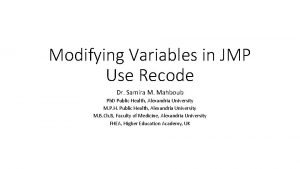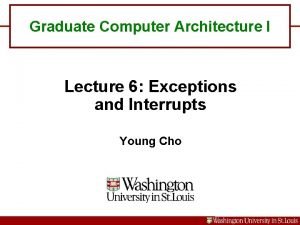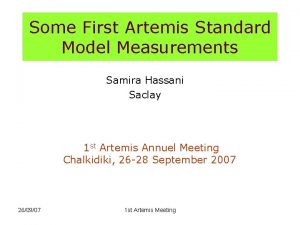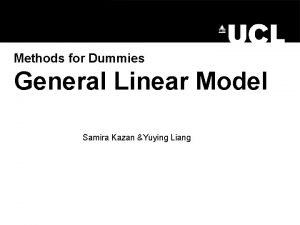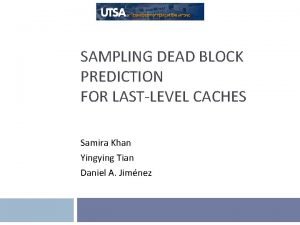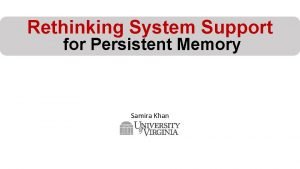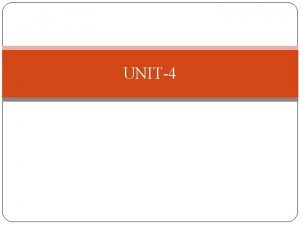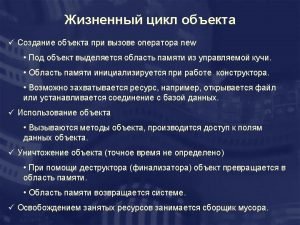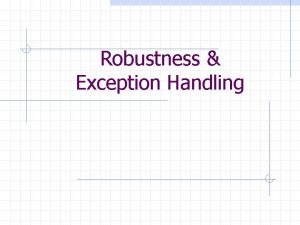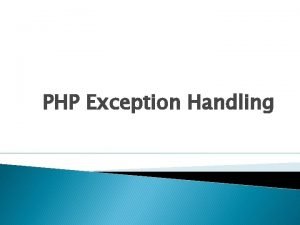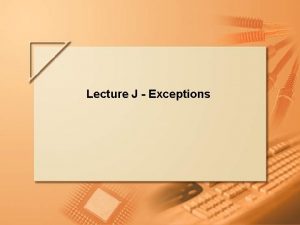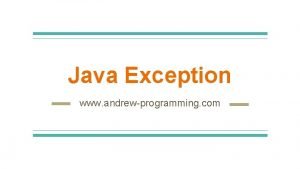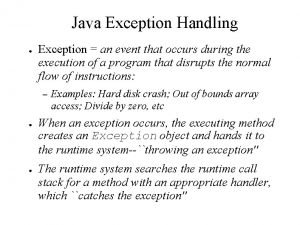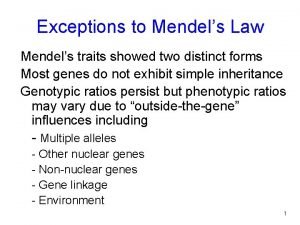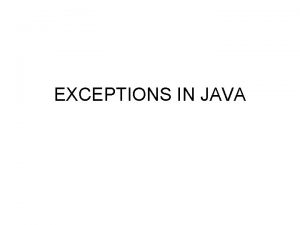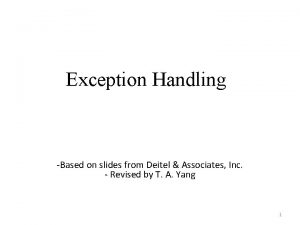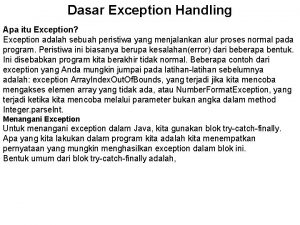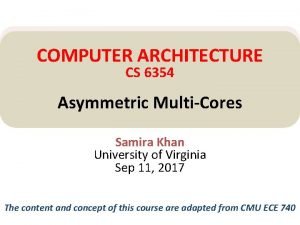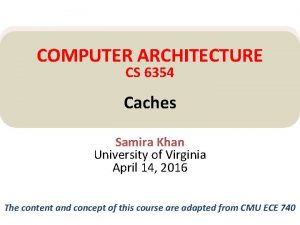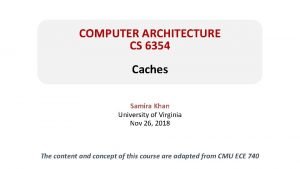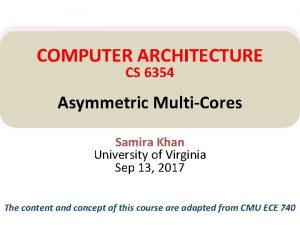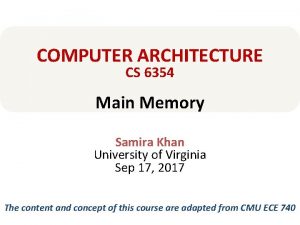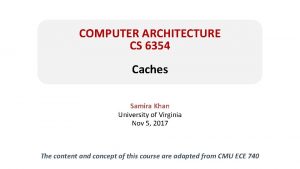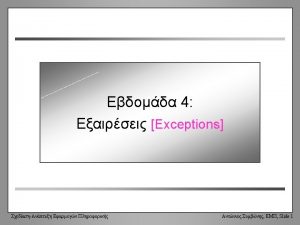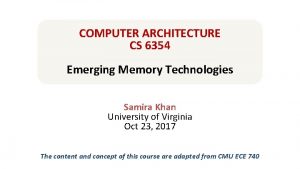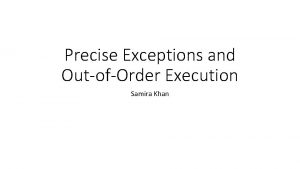COMPUTER ARCHITECTURE CS 6354 Precise Exception Samira Khan































- Slides: 31

COMPUTER ARCHITECTURE CS 6354 Precise Exception Samira Khan University of Virginia Feb 9, 2016 The content and concept of this course are adapted from CMU ECE 740

AGENDA • Review from last lecture – Pipelining – Issues in Pipelining: Control & Data Dependence – State Maintenance and Recovery • Continue State Maintenance and Recovery 2

ISSUES IN PIPELINING: MULTI-CYCLE EXECUTE • Instructions can take different number of cycles in EXECUTE stage – Integer ADD versus FP Multiply FMUL R 4 R 1, R 2 ADD R 3 R 1, R 2 FMUL R 2 R 5, R 6 ADD R 4 R 5, R 6 F D E E E E W F D E E E F D E W F D E E W W – What is wrong with this picture? • What if FMUL incurs an exception? • Sequential semantics of the ISA NOT preserved! 3

• Reorder buffer SOLUTIONS • History buffer • Future register file • Checkpointing • Reading – Smith and Plezskun, “Implementing Precise Interrupts in Pipelined Processors” IEEE Trans on Computers 1988 and ISCA 1985. – Hwu and Patt, “Checkpoint Repair for Out-of-order Execution Machines, ” ISCA 1987. 4

SOLUTION I: REORDER BUFFER (ROB) • Idea: Complete instructions out-of-order, but reorder them before making results visible to architectural state • When instruction is decoded it reserves an entry in the ROB • When instruction completes, it writes result into ROB entry • When instruction oldest in ROB and it has completed, its result moved to reg. file or memory Func Unit Instruction Cache Register File Func Unit Reorder Buffer Func Unit 5

REORDER BUFFER: INDEPENDENT OPERATIONS • Results first written to ROB, then to register file at commit time F D E E E E F D E R F D E E E F D E R F D E E R W W E E E R W W R W • What if a later operation needs a value in the reorder buffer? – Read reorder buffer in parallel with the register file. How? 6

REORDER BUFFER: HOW TO ACCESS? • A register value can be in the register file, reorder buffer, (or bypass paths) Instruction Cache Register File Func Unit Content Addressable Memory (searched with register ID) Reorder Buffer Func Unit bypass path 7

SIMPLIFYING REORDER BUFFER ACCESS • Idea: Use indirection • Access register file first – If register not valid, register file stores the ID of the reorder buffer entry that contains (or will contain) the value of the register – Mapping of the register to a ROB entry • Access reorder buffer next 8

REGISTER RENAMING WITH A REORDER BUFFER • Output and anti dependencies are not true dependencies – WHY? The same register refers to values that have nothing to do with each other – They exist due to lack of register ID’s (i. e. names) in the ISA • The register ID is renamed to the reorder buffer entry that will hold the register’s value – Register ID ROB entry ID – Architectural register ID Physical register ID – After renaming, ROB entry ID used to refer to the register • This eliminates anti- and output- dependencies – Gives the illusion that there a large number of registers 9

REORDER BUFFER IN INTEL PENTIUM III Boggs et al. , “The Microarchitecture of the Pentium 4 Processor, ” Intel Technology Journal, 2001. 10

REORDER BUFFER PROS AND CONS • Pro – Conceptually simple for supporting precise exceptions • Con – Reorder buffer needs to be accessed to get the results that are yet to be written to the register file • CAM or indirection increased latency and complexity 11

SOLUTION II: HISTORY BUFFER (HB) • Idea: Update architectural state when instruction completes, but UNDO UPDATES when an exception occurs • When instruction is decoded, it reserves an HB entry • When the instruction completes, it stores the old value of its destination in the HB • When instruction is oldest and no exceptions/interrupts, the HB entry discarded • When instruction is oldest and an exception needs to be handled, old values in the HB are written back into the architectural state from tail to head 12

HISTORY BUFFER Func Unit Instruction Cache Register File Func Unit History Buffer Func Unit • Advantage: Used only on exceptions – Register file contains up-to-date values. History buffer access not on critical path • Disadvantage: – Need to read the old value of the destination – Need to unwind the history buffer upon an exception increased exception/interrupt handling latency 13

COMPARISON OF TWO APPROACHES • Reorder buffer – Pessimistic register file update – Update only with non-speculative values (in program order) – Leads to complexity/delay in accessing the new values • History buffer – Optimistic register file update – Update immediately, but log the old value for recovery – Leads to complexity/delay in logging old values • Can we get the best of both worlds? – Idea: Have both types of register files 14

SOLUTION III: FUTURE FILE (FF) • Idea: Keep two register files: – Arch reg file: Updated in program order for precise exceptions – Future reg file: Updated as soon as an instruction completes (if the instruction is the youngest one to write to a register) • Future file is used for fast access to latest register values (speculative state) – Frontend register file • Architectural file is used for recovery on exceptions (architectural state) – Backend register file 15

FUTURE FILE Func Unit Instruction Cache Future File Data or Tag V • Advantage Func Unit ROB Arch. File Func Unit Used only on exceptions – No sequential scanning of history buffer: Upon exception, simply copy arch file to future file – No need for extra read of destination value • Disadvantage – Multiple register files + reorder buffer 16

IN-ORDER PIPELINE WITH FUTURE FILE AND REORDER BUFFER • Decode (D): Access future file, allocate entry in ROB, check if instruction can execute, if so dispatch instruction • Execute (E): Instructions can complete out-of-order • Completion (R): Write result to reorder buffer and future file • Retirement/Commit (W): Check for exceptions; if none, write result to architectural register file or memory; else, flush pipeline, copy architectural file to future file, and start from exception handler • In-order dispatch/execution, out-of-order completion, in-order retirement Integer add E E F D E E Integer mul E E E E E FP mul R W . . . Load/store 17

CAN WE REDUCE THE OVERHEAD OF TWO REGISTER FILES? • Idea: Use indirection, i. e. , pointers to data in frontend and retirement – Have a single storage that stores register data values – Keep two register maps (speculative and architectural); also called register alias tables (RATs) • Future map used for fast access to latest register values (speculative state) – Frontend register map • Architectural map is used for state recovery on exceptions (architectural state) – Backend register map 18

FUTURE MAP IN INTEL PENTIUM 4 Boggs et al. , “The Microarchitecture of the Pentium 4 Processor, ” Intel Technology Journal, 2001. Many modern processors are similar: - MIPS R 10 K - Alpha 21264 19

REORDER BUFFER VS. FUTURE MAP COMPARISON 20

BEFORE WE GET TO CHECKPOINTING… • Let’s cover what happens on exceptions • And branch mispredictions 21

HANDLING EXCEPTIONS IN PIPELINING • When the oldest instruction ready-to-be-retired is detected to have caused an exception, the control logic – Recovers architectural state (register file, IP, and memory) – Flushes all younger instructions in the pipeline – Saves IP and registers (as specified by the ISA) – Redirects the fetch engine to the exception handling routine 22

PIPELINING ISSUES: BRANCH MISPREDICTIONS • A branch misprediction resembles an “exception” – Except it is not visible to software (i. e. , it is microarchitectural) • What about branch misprediction recovery? – Similar to exception handling except can be initiated before the branch is the oldest instruction (not architectural) – All three state recovery methods can be used • Difference between exceptions and branch mispredictions? – Branch mispredictions are much more common need fast state recovery to minimize performance impact of mispredictions 23

HOW FAST IS STATE RECOVERY? • Latency of state recovery affects – Exception service latency – Interrupt service latency – Latency to supply the correct data to instructions fetched after a branch misprediction • Which ones above need to be fast? • How do the three state maintenance methods fare in terms of recovery latency? – Reorder buffer – History buffer – Future file 24

BRANCH STATE RECOVERY ACTIONS AND LATENCY • Reorder Buffer – Flush instructions in pipeline younger than the branch – Finish all instructions in the reorder buffer • History buffer – Flush instructions in pipeline younger than the branch – Undo all instructions after the branch by rewinding from the tail of the history buffer until the branch & restoring old values one by one into the register file • Future file – Wait until branch is the oldest instruction in the machine – Copy arch. reg. file to future file – Flush entire pipeline 25

CAN WE DO BETTER? • Goal: Restore the frontend state (future file) such that the correct next instruction after the branch can execute right away after the branch misprediction is resolved • Idea: Checkpoint the frontend register state/map at the time a branch is decoded and keep the checkpointed state updated with results of instructions older than the branch – Upon branch misprediction, restore the checkpoint associated with the branch n Hwu and Patt, “Checkpoint Repair for Out-of-order Execution Machines, ” ISCA 1987. 26

CHECKPOINTING • When a branch is decoded – Make a copy of the future file/map and associate it with the branch • When an instruction produces a register value – All future file/map checkpoints that are younger than the instruction are updated with the value • When a branch misprediction is detected – Restore the checkpointed future file/map for the mispredicted branch when the branch misprediction is resolved – Flush instructions in pipeline younger than the branch – Deallocate checkpoints younger than the branch 27

CHECKPOINTING • Advantages – Correct frontend register state available right after checkpoint restoration Low state recovery latency –… • Disadvantages – Storage overhead – Complexity in managing checkpoints –… 28

MANY MODERN PROCESSORS USE CHECKPOINTING • MIPS R 10000 • Alpha 21264 • Pentium 4 • Yeager, “The MIPS R 10000 Superscalar Microprocessor, ” IEEE Micro, April 1996 • Kessler, “The Alpha 21264 Microprocessor, ” IEEE Micro, March-April 1999. • Boggs et al. , “The Microarchitecture of the Pentium 4 Processor, ” Intel Technology Journal, 2001. 29

SUMMARY: MAINTAINING PRECISE STATE • Reorder buffer • History buffer • Future register file • Checkpointing • Readings – Smith and Plezskun, “Implementing Precise Interrupts in Pipelined Processors, ” IEEE Trans on Computers 1988 and ISCA 1985. – Hwu and Patt, “Checkpoint Repair for Out-of-order Execution Machines, ” ISCA 1987. 30

COMPUTER ARCHITECTURE CS 6354 Precise Exception Samira Khan University of Virginia Feb 9, 2016 The content and concept of this course are adapted from CMU ECE 740
 Computer architecture
Computer architecture Samira khan uva
Samira khan uva Jmp recode
Jmp recode What is exception in computer architecture
What is exception in computer architecture Artemis
Artemis Samira zegrari
Samira zegrari Samira kazan
Samira kazan Samira soltani
Samira soltani Samira kazan origin
Samira kazan origin Samira block
Samira block How to counter samira
How to counter samira Bus architecture in computer architecture
Bus architecture in computer architecture Diff between computer organization and architecture
Diff between computer organization and architecture Basic computer organization
Basic computer organization Hierarchy of thread class in java
Hierarchy of thread class in java System argument exception
System argument exception 1c=142a=0 after try/catch blocks
1c=142a=0 after try/catch blocks Class a void foo() throws exception
Class a void foo() throws exception Class a void foo() throws exception
Class a void foo() throws exception Exception handler php
Exception handler php Unt concur
Unt concur Coccus
Coccus Runtimeexception extends exception
Runtimeexception extends exception What is exception
What is exception Exception vs error in java
Exception vs error in java Exception handling pl sql
Exception handling pl sql Exceptions of mendel's law
Exceptions of mendel's law Exception class hierarchy in java
Exception class hierarchy in java Exception handling in vb net
Exception handling in vb net Exception handling in java
Exception handling in java Charting by exception pros and cons
Charting by exception pros and cons Exception handling pada java
Exception handling pada java


